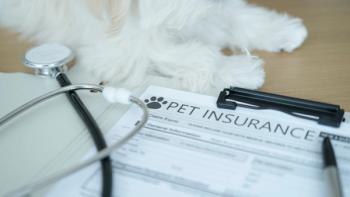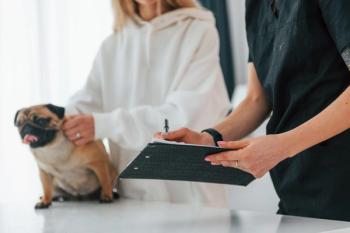
Veterinary exam room evolution
Take a look at how the high temple of veterinary medicine-otherwise known as the exam room-has changed with the times and where it's going.
Take a look at how the high temple of veterinary medicine-otherwise known as the exam room-has changed with the times and where it's going.
The exam room is ground zero for a veterinary practice. This is where most of the interactions between doctor and client take place. It's a place for tears and affirmations. It's no wonder that we architects spend so much time fretting over the little details of the exam room with practice owners and veterinarians.
What can we learn from thousands of exam rooms built over the past several decades? Have we forgotten anything important along the way? And how do we set the stage for the next generation of conversations between doctors and clients?
Click next to find out.
In the beginning
In the early history of full-service veterinary hospitals, the exam room was an open, multipurpose space that might also have been used for treatment and surgery. There was very little separation between doctors and clients, and the room was finished in a practical and durable manner. Part of this pragmatic approach was due to the fact that a much greater percentage of pets that visited the hospital were injured or ill. This photo from the American Animal Hospital Association (AAHA) archives illustrates the dull design from the past.
With the growth of wellness and specialty care, exam rooms became enclosed spaces, separated from medical areas, where doctors and clients could converse. Greater emphasis was put on client comfort and privacy, and over the years, exam rooms became larger and more elaborate, like this one at Alexandria Veterinary Clinic PetCare Center in Alexandria, Minn.
Creative Impact DesignWe are currently seeing a shift in the way exam rooms are designed. While the exam room will remain focused on the client, its design will incorporate some older ideas along with new ones. In this way, the exam room will be more recombinant than unique. To explore this thought, let's review some defining concepts from the exam room archives.
One door versus two
Initially, exam rooms had one access door. But two-door “flow through” exam rooms became the norm from the 1970s until recently. Part of the reason for two doors was the idea that clients and doctors should have separate circulation paths, and another part of the reason had to do with safety-your client could have a T-Rex in the room. But as more clients come in with cats and lap dogs, the escape route has become less necessary. Today, there are many economic factors to contend with, and the one-door exam room is a great way to do more with less space, as seen in Upstate Veterinary Specialists in Asheville, N.C. Ironically, a benefit of moving back to one door is that clients and doctors do enter from the same side of the room, which sets a precedent for the informal relationships that younger clients prefer.
David Dietrich Custom versus prefabricated equipment
I have visited many hospitals that can't bear to part with that ginormous, vintage, stainless-steel exam table. Part of the problem is that the beastly thing just refuses to wear out. Of course, there are much nicer versions of prefabricated tables today, including those that fold away when they're not needed, like the one below in Coral Springs Animal Hospital, Coral Springs, Fla. But why would we keep buying anything prefabricated, no matter how nice and new it is, when we have decades of creative custom cabinet designs right at our Googling fingertips?
It is my hunch that despite the diversity of possible custom solutions, prefabricated equipment will be more important in the exam room of the future. Part of this is, again, economic-equipment depreciates, which is useful on the accounting side, and fewer veterinarians have the money to build the Taj Ma-vet. But the other side of it is that the vendors that make equipment keep improving it. At this point, there isn't a real advantage to designing a custom exam table when you can buy a James Bond version that lifts, rotates and weighs. Eventually, it too may look like a relic from the past, but in the meantime, it helps you get the job done while focusing on what is really important: the care and treatment of your clients and their pets.
Foto ImagerySpecies-specific rooms
For a while during the early 1990s, we got obsessed with the idea that dog and cat clients should be handled separately. There were dog doors and cat doors, dog waiting areas and cat waiting areas, dog exam rooms and cat exam rooms, even separate dog and cat treatment and wards. Unfortunately the general public resolutely refuses to read signs, so people inevitably ended up going through the wrong door. And what about that client with the dog and the cat? While the idea of separating cats from dogs seemed one destined for the “well, that didn't work” category, I think it's going to make a bit of resurgence in the exam room itself.
We all know that most cats rank their experience with the veterinarian as being somewhere between vile and horrifying. Anything that we can do to reduce their fear and stress at the veterinarian's office is a win for the practice and the client alike. One thing we can do is to keep cats away from dogs. As Fear Free practice becomes a mantra for all of us, separating feline exam rooms from canine exam rooms just makes sense. The cat-only exam room at Boca Park Animal Hospital in Las Vegas, Nev., features a facial pheromone device (not pictured) and a cat tree.
Sirius ProductionsClosed versus open exam rooms
Take it from those of us who have logged many hours in exam rooms: most of them are not much better than solitary confinement. There's nothing to do, little to look at and not much to listen to other than the panting of an anxious pet. Over time, we have designed exam rooms to be closed because that's what we wanted to do, but not because that's what clients wanted us to do.
Several years ago, we designed Clocktower Animal Hospital in Herndon, Va. One unusual feature of the plan was that it had an exam room that was completely open. No walls, no problem? While it was a good idea, the open exam room was too radically different to catch on. And admittedly, it does have its own shortcomings.
Panoramic VisionsPerhaps there is a middle ground. How about a room that maintains privacy while still letting clients see out, like the one below at Woodhaven Veterinary Hospital in Edmonds, Wash.? How about a room with a nice big window, perhaps even one that opens? What about an indoor/outdoor exam room surrounded by a garden? Ultimately, it is these larger questions of a client's experience in the exam room that will shape the hospitals of the future.
Foto ImageryThe exam rooms of the future will borrow new ideas and old ideas and recombine them in resourceful ways. I believe that these three lessons will guide the designs of future exam rooms:
> Don't be afraid to break down a barrier between the doctor space and the client space, or between client space and the out-of-doors.
> Cater to dog and cat patients separately.
> Invest in the greater experience for your clients and their beloved pets, and prioritize this over all else!
Heather Lewis is a partner at Animal Arts, a veterinary design firm based in Boulder, Colo.
The exam room is ground zero for a veterinary practice. This is where most of the interactions between doctor and client take place. It's a place for tears and affirmations. It's no wonder that we architects spend so much time fretting over the little details of the exam room with practice owners and veterinarians.
What can we learn from thousands of exam rooms built over the past several decades? Have we forgotten anything important along the way? And how do we set the stage for the next generation of conversations between doctors and clients?
In the beginning
In the early history of full-service veterinary hospitals, the exam room was an open, multipurpose space that might also have been used for treatment and surgery. There was very little separation between doctors and clients, and the room was finished in a practical and durable manner. Part of this pragmatic approach was due to the fact that a much greater percentage of pets that visited the hospital were injured or ill. This photo from the American Animal Hospital Association (AAHA) archives illustrates the dull design from the past.
With the growth of wellness and specialty care, exam rooms became enclosed spaces, separated from medical areas, where doctors and clients could converse. Greater emphasis was put on client comfort and privacy, and over the years, exam rooms became larger and more elaborate, like this one at Alexandria Veterinary Clinic PetCare Center in Alexandria, Minn.
Creative Impact Design
We are currently seeing a shift in the way exam rooms are designed. While the exam room will remain focused on the client, its design will incorporate some older ideas along with new ones. In this way, the exam room will be more recombinant than unique. To explore this thought, let's review some defining concepts from the exam room archives.
One door versus two
Initially, exam rooms had one access door. But two-door “flow through” exam rooms became the norm from the 1970s until recently. Part of the reason for two doors was the idea that clients and doctors should have separate circulation paths, and another part of the reason had to do with safety-your client could have a T-Rex in the room. But as more clients come in with cats and lap dogs, the escape route has become less necessary. Today, there are many economic factors to contend with, and the one-door exam room is a great way to do more with less space, as seen in Upstate Veterinary Specialists in Asheville, N.C. Ironically, a benefit of moving back to one door is that clients and doctors do enter from the same side of the room, which sets a precedent for the informal relationships that younger clients prefer.
David Dietrich
Custom versus prefabricated equipment
I have visited many hospitals that can't bear to part with that ginormous, vintage, stainless-steel exam table. Part of the problem is that the beastly thing just refuses to wear out. Of course, there are much nicer versions of prefabricated tables today, including those that fold away when they're not needed, like the one below in Coral Springs Animal Hospital, Coral Springs, Fla. But why would we keep buying anything prefabricated, no matter how nice and new it is, when we have decades of creative custom cabinet designs right at our Googling fingertips?
It is my hunch that despite the diversity of possible custom solutions, prefabricated equipment will be more important in the exam room of the future. Part of this is, again, economic-equipment depreciates, which is useful on the accounting side, and fewer veterinarians have the money to build the Taj Ma-vet. But the other side of it is that the vendors that make equipment keep improving it. At this point, there isn't a real advantage to designing a custom exam table when you can buy a James Bond version that lifts, rotates and weighs. Eventually, it too may look like a relic from the past, but in the meantime, it helps you get the job done while focusing on what is really important: the care and treatment of your clients and their pets.
Foto Imagery
Species-specific rooms
For a while during the early 1990s, we got obsessed with the idea that dog and cat clients should be handled separately. There were dog doors and cat doors, dog waiting areas and cat waiting areas, dog exam rooms and cat exam rooms, even separate dog and cat treatment and wards. Unfortunately the general public resolutely refuses to read signs, so people inevitably ended up going through the wrong door. And what about that client with the dog and the cat? While the idea of separating cats from dogs seemed one destined for the “well, that didn't work” category, I think it's going to make a bit of resurgence in the exam room itself.
We all know that most cats rank their experience with the veterinarian as being somewhere between vile and horrifying. Anything that we can do to reduce their fear and stress at the veterinarian's office is a win for the practice and the client alike. One thing we can do is to keep cats away from dogs. As Fear Free practice becomes a mantra for all of us, separating feline exam rooms from canine exam rooms just makes sense. The cat-only exam room at Boca Park Animal Hospital in Las Vegas, Nev., features a facial pheromone device (not pictured) and a cat tree.
Sirius Productions
Closed versus open exam rooms
Take it from those of us who have logged many hours in exam rooms: most of them are not much better than solitary confinement. There's nothing to do, little to look at and not much to listen to other than the panting of an anxious pet. Over time, we have designed exam rooms to be closed because that's what we wanted to do, but not because that's what clients wanted us to do.
Several years ago, we designed Clocktower Animal Hospital in Herndon, Va. One unusual feature of the plan was that it had an exam room that was completely open. No walls, no problem? While it was a good idea, the open exam room was too radically different to catch on. And admittedly, it does have its own shortcomings.
Panoramic Visions
Perhaps there is a middle ground. How about a room that maintains privacy while still letting clients see out, like the one below at Woodhaven Veterinary Hospital in Edmonds, Wash.? How about a room with a nice big window, perhaps even one that opens? What about an indoor/outdoor exam room surrounded by a garden? Ultimately, it is these larger questions of a client's experience in the exam room that will shape the hospitals of the future.
Foto Imagery
The exam rooms of the future will borrow new ideas and old ideas and recombine them in resourceful ways. I believe that these three lessons will guide the designs of future exam rooms:
> Don't be afraid to break down a barrier between the doctor space and the client space, or between client space and the out-of-doors.
> Cater to dog and cat patients separately.
> Invest in the greater experience for your clients and their beloved pets, and prioritize this over all else!
Heather Lewis is a partner at Animal Arts, a veterinary design firm based in Boulder, Colo.
Newsletter
From exam room tips to practice management insights, get trusted veterinary news delivered straight to your inbox—subscribe to dvm360.






